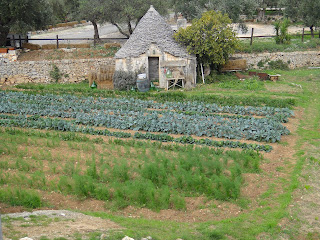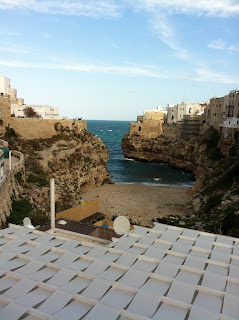Leaving Bassilicata today and busing through the region of Puglia to the city of Lecce.
Puglia is a very stoney area, Much like in New England the farmers dug the stones out of their fields and built walls with them. Actually they build everything with them. The saying is: "everything starts from the stones". One nickname for the area is Puglia-shire since there are so many British who have bought homes, and land here. It is very like the English countryside.
Alberobella
We are headed to Alberobello a town famous for one kind of stone constructed house called a Trulli. Trullis are conical roofed houses constructed with no mortar.
In the Middle Ages at some point, taxes were collected, not based on number of houses, but based on the mortar used. So, the resourceful Italians here, built their houses without any mortar. They could also dismantle their houses one step ahead of the tax man - since they were like a giant erector kit - and reconstruct them in a different location.
Alberobello has thousands of these houses arranged along narrow winding paths - looking very like a hobbit-ville.
Lunch today is at a very good restaurant called Il Poeta Contadino. Here is the menu:
. fava bean puree, potato dumpling with sausage and chicory, dried tomato
. orechiette (pasta) with turnip tops and cherry tomatoes
. chocolate cake with orange cream and fresh oranges
Typing this out, it doesn't look nearly as delicious as it was in real life. Yum!!
Ostuni
Side trip to Ostuni - a white city on a hill surrounded by millions of olive trees. Ostumi is a walled city with a strong Arabic influence. The buildings were white-washed every year - a practice that probably saved them from the plague. The people attributed the fact that the plague seemed to have passed them by to the intercession of their patron saint, Saint Oronzo.
Olive trees live a long time here. Many of the trees we are seeing in groves as we ride the bus from city to city look ancient - maybe 500-600 years old. The trunks are gnarly, thick and have frequently split into two pieces spiraling around an empty center. These old trees still produce lots of olives. You can really see why people thought that trees had spirits - the trunks, so gnarly and complex.
Lecce
Lecce is full of baroque buildings - called the Florence of the South. Our guide in Lecce is Daniella. Here we see more churches than we've seen in the whole first week of the tour. Daniella seems more religious than our other guides and talks quite a bit about Saint Oronzo.
 |
| from our hotel window |
The gargoyles and other stone figures I see on the buildings here in Lecce, have a different character than on baroque buildings in other cities. Many of them seem more cartoon-like, less threatening and monster like.
See what I mean?
Perhaps one of the highlights of the trip for me is a visit we make in Lecce to a Palazzo built in the 1500s. We walk there in the evening, are greeted by several young women when we enter the courtyard. Then we climb a flight of large stone steps into the private rooms of the current owner, Mr Fernando. He inherited this large house from his mother. We sit in his library and he talks to us about the house, it's history, and tells some stories about it's inhabitants. Gaetano translates - so there is a musical back-and-forth between the two men, Italian, and Italian-accented English.
We are led through a few more rooms and then descend the stairs again to the former stables of the house where we have a tasting of local wines, and a buffet dinner.
After dinner, musicians enter the room playing loudly on accordion, 2 large tambourines and guitar. The sound is huge. Then they sing they lift up their faces and produce a full-throated, dense sound. It reminds me of the 'throat singers' from parts of Eastern Europe. The vibrations are felt all around the room. They immediately captured the crowd with their passionate sounds. The name of the group is Criamu.
They also got most of us up and dancing the Pizzica - a kind of local tarantella. My kind of night!!
Busing today along the Adriatic Sea through the region of Apulia (which means 'no rain'!) to Otranto, then west to Gallipoli.
In Otranto we visit the Basilica de Annunciato, an 11th century mosaic floor covering the entire church depicting a 'tree of life'.
A side chapel in the church contains the bones of 80 men martyred by the Turks.



























Just lovely, Anita! It brought back great memories and was such fun to read!
ReplyDeleteThank you so much for sharing this one. I like your place because I think you have a very clean and relaxing ambiance. I'm sure to come here soon. Keep on sharing! By the way having a hard time in hotel lecce? Browse here.
ReplyDelete